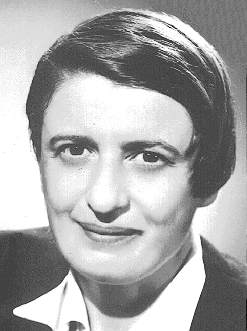Risk Taking Researcher
Anthem
Ayn Rand
Week #1
Part 1 and 2
 |
| Image Citation |
While reading Part 1 and Part 2 of the book, Anthem, I asked myself several questions. questions such as, " Why is the main character called Equality 7-2521 ? " , " Why is it that Equality 7-2521 refers to itself as we ? " and " Where is it that this story takes place ? ". Realizing that it might be hard to understand the story having so many questions, I decided it would be good to make some research about Anthem.
Setting: Anthem is set in a dystopian society: a society that's the opposite of a utopia. More specifically, it's set in a community in which every aspect of every individual's life is controlled by the government. The City seems to be a self-sustaining unit, with its own ruling Councils, its own agriculture, and all of the professions needed to sustain it on its own. The story of Anthem takes place in some unspecified future time and place in which freedom and individual rights have been obliterated. Collectivism, the political philosophy holding that an individual exists solely to serve the state, is dominant and has led to the establishment of a global dictatorship of the Fascist or Communist variety.
 |
| Image Citation |
Main Character: Equality 7-2521's got it all. He's young, beautiful, tall, strong, fearless, and brilliant. Equality 7-2521 re-invents the electric light, and in so doing, manages to surpass the best Scholars of his society by leaps and bounds in only a couple of years. And Equality 7-2521's brilliance doesn't just extend to science alone. By the end of the novel, he's writing impassioned philosophical anthems on the meaning of life.
Genre: Anthem is definitely a piece of dystopian literature: it's all about the nightmarish society where essentially everything is bad. Like the other classics of the genre, such as, 1984, Brave New World and the Giver, it's also meant to me a warning that we may be heading there.Anthem's also clearly a work of philosophical literature. It's meant to illustrate and promote Ayn Rand's own distinctive philosophy of egoism, and to critique all forms of collectivism. The two opposed worldviews are embodied in the story's heroes, on the one hand, and the evil and oppressive society that opposes them, on the other Rand's philosophy is called Objectivism, but she hadn't yet come up with the name or all of the elements of her later Objectivism when she wrote this book.
 |
| Image Citation |
About the Author: Ayn Rand was born in St. Petersburg, Russia, on February 2, 1905 and at the age of six she taught herself to read. At the age of nine she decided to make fiction writing her career. Thoroughly opposed to the mysticism and collectivism of Russian culture, she thought of herself as a European writer, especially after encountering Victor Hugo, the writer she most admired. In late 1925 she obtained permission to leave Soviet Russia for a visit to relatives in the United States. Although she told Soviet authorities that her visit would be short, she was determined never to return to Russia. She arrived in New York City in February 1926. She spent the next six months with her relatives in Chicago, obtained an extension to her visa, and then left for Hollywood to pursue a career as a screenwriter. In creating her novels, Rand sought to make real her exalted view of man of life. For millions of readers, the experience of entering Rand's universe proves unforgettable memories. Ayn Rand died March 6, 1982 in New York City.
Juan,
ReplyDeleteI also was the researcher for part one and two of the book, and I feel I understand the book better after researching. I hope you also do now because the next time I pick up the book to read I will have more background information which will make the story flow in a better rhythm and pace. Additionally, your images also helped with the research because I always understand the text better after I see images. Great job on your post!
Juan,
ReplyDeleteYour post was really brilliant, though I think you moved a little bit forward, meaning that the questions you had, most of them could have been answered afterwards in the book. I enjoyed your post because it makes clear a lot of mysteries in the book, like why Ayn Rand wrote the book because she lived in a communist society when she was young. One thing that keeps haunting me is the “we“ think. My opinion is that he says “we“ because is selfish to say “I“. What do you think?
Good Job,
Ha